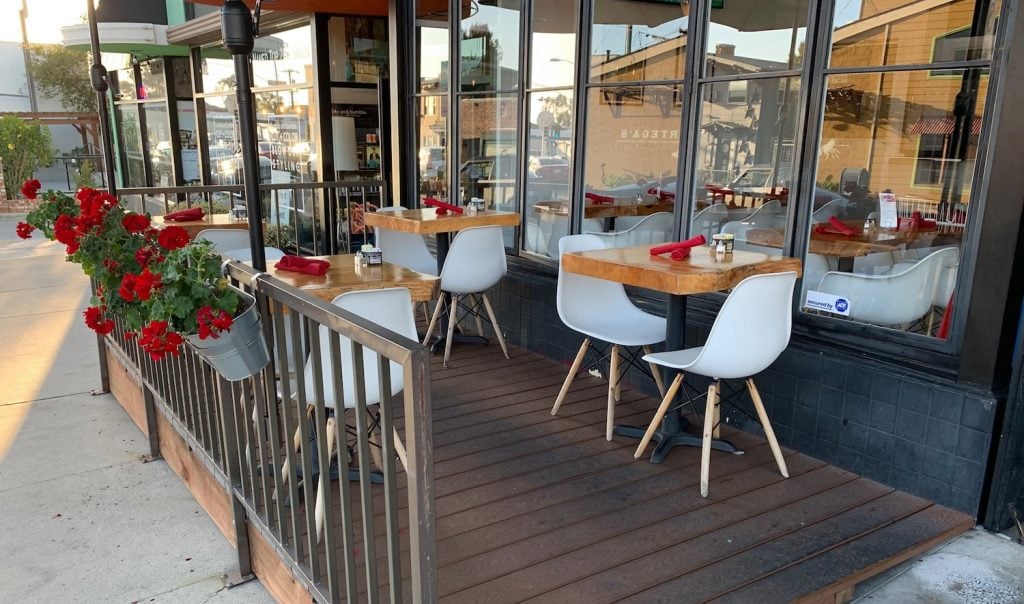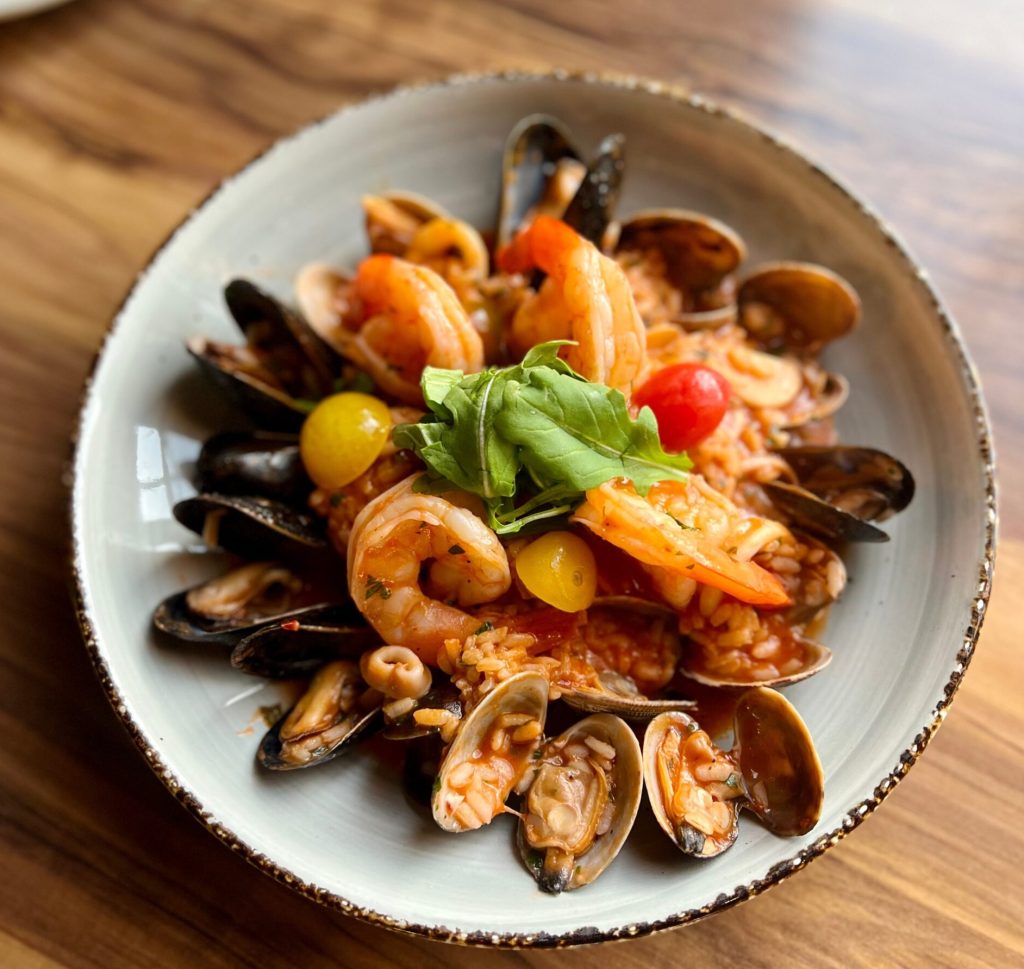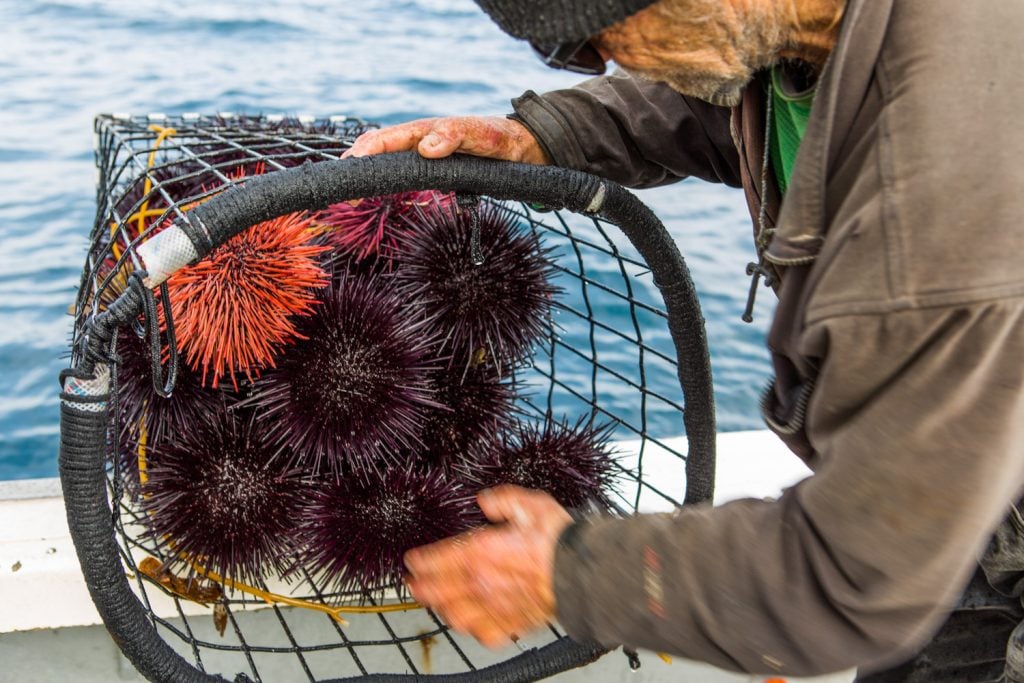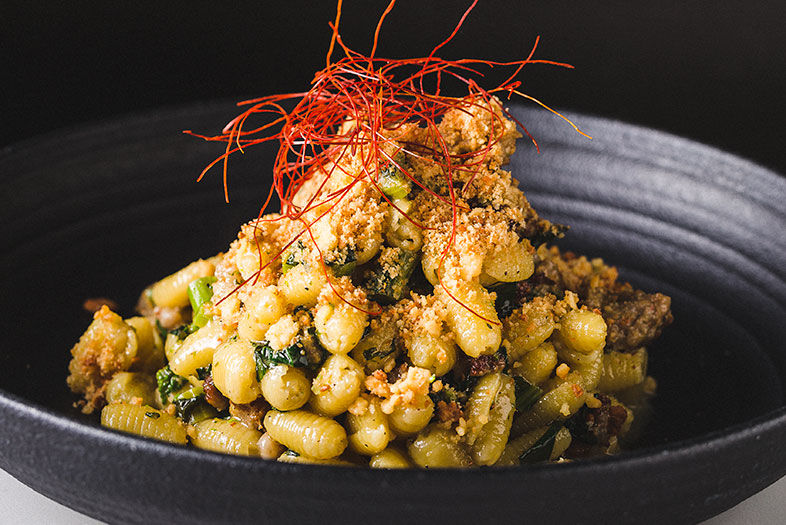Maestoso
1040 University Avenue, Hillcrest maestoso
BEST DISHES
Duck Pinsa
Salsiccia and Broccoletti
Uovo di Limone
It smells like well-warmed dough and freshly cracked pepper. So much cracked pepper. Pepper is the official love dust of Rome. It tickles the air in Maestoso.
The air is also full of Italian. Most of Maestoso’s staff speaks the mother tongue, dabbling in essential restaurant English. Most of them have been imported for this project by chef Marco Maestoso. Once, when the Italian soccer team played an exhibition match in San Diego, the chefs watched out the window until they spotted the team jet (an unmarked white charter) fly over Hillcrest. Chef Marco told one of his cooks to hop on his motorcycle and hunt the team down at the airport.

Maestoso Is a Rewarding Taste of Rome, and Equally Confusing to Navigate
Justin McChesney-Wachs
He did. He begged, cajoled. And the soccer team ate there for the entire week of their visit. “I might quit after that,” Maestoso tells us. Everything Italian matters here, especially the guanciale.
Maestoso is in a strip mall. It’s a boutique strip mall in San Diego’s traditionally gay neighborhood. Hillcrest’s siren song has always been individuality at all costs. Still, strip malls tend to swallow originality into that desolate topography of stucco. Maestoso manages to retain a sense of self in two ways—the design (a fake exterior plant wall twinkles with lights, a canopy of fake ivy provides shade and shelter on the patio, the singularly conspicuous leather banquet in the dining room that’s Kalamata olive green), and the Italian-speaking chefs.
The chefs are Maestoso’s show.

Maestoso Is a Rewarding Taste of Rome, and Equally Confusing to Navigate
A chef wheels around a cart displaying daily specials
They call it “chef to table.” The model is nothing new for a-guy-and-a-window joints. But for a gourmet kitchen run by a chef with Michelin-starred mentors—a restaurant curing its own meats, submerging proteins in the weightless magic of sous vide, and choosing Italian wines like only a native could—it’s a strange, new, DIY world. Five years ago, a place of Maestoso’s caliber would have had a small army of attendants roaming the floor, catering to the tiniest needs, preening the room, grooming the minutiae. But for California’s neighborhood restaurants, that populated-staff model is now a model for bankruptcy.
Neighborhood restaurants are ghost-towning the front of their houses. Minimum wage is rising. The state refuses to let them count tips as earnings. So restaurant after restaurant is bidding a heartfelt farewell to service staff. The chef’s hand must now also be the glad hand. If this continues, we’ll all soon be standing around the chef’s stove, heralding the “pan to mouth” movement.

Maestoso Is a Rewarding Taste of Rome, and Equally Confusing to Navigate
A Pork Cheek Sour cocktail made with sake, pork cheek, lemon, allspice syrup, and bitters
Aside from the loss of server jobs, it’s not an entirely bad thing. It brings diners face to face with their makers. You will meet 31-year-old chef Marco at Maestoso, his wife (a partner and the general manager), and the other chefs. He may deliver your meal and fill your glass of Barolo. You will see them sing “Happy Birthday” in Italian to guests, bringing an old, awkward heartwarming to the room. You’re family, like it or not. And like any modern family, Maestoso is confusing to navigate. It’s set up around its kitchen, where pizzaioli crank and cut fresh dough for their pastas and “pinsas” (we’ll explain that in a second), and finish dishes with herbed oils, citrus zests, and the holy Roman pecorino cheese. They also rove the floor with a cart displaying small daily specials, hot and cold, that aren’t on the menu. It’s like Roman dim sum.
Do you wait to inspect the creations on the carts before ordering from the menu? It’s unclear. I need a big sign explaining “How to Maestoso.” Or a chef needs to give each new guest a primer, an explanation, a prayer at doing this right. Because when you finally figure out how to order, the results are inspiring.

Maestoso Is a Rewarding Taste of Rome, and Equally Confusing to Navigate
Maestoso’s indoor dining room
The unique star in its many variations is the pinsa, an airier, lighter riff on pizza. Whereas pizza dough is a chewy-thick ode to the muscle of gluten and flour, pinsa uses 17 whole grains, rice flour, a touch of soy protein, and minimal wheat flour. Maestoso claims the result is more easily processed by our digestive systems, which are at a historic frailty. True or not, it’s definitely more delicious, puffed to look like a deep dish but full of warm, humid, bready air inside that tastes of toasted grains. It’s like they’ve discovered a way to eat that intoxicating scent of a good bakery. The pinsa with confit duck breast, wild boar salami, and goat cheese over a dried fig compote is especially emotional. It tastes like a charcuterie board having a midlife crisis as a sort-of pizza, an experiment gone terribly, terribly right.
The artichoke enjoys near-papal status in Rome, and both ways we have them are sublime—whether fried (a staple among Rome’s large Jewish population) with a garlic aioli, or served cold, marinated in oil and herbs. We find both carpaccio presentations—one beef, one paper-thin octopus shavings—in need of a finishing oil. One night a special is beef stroganoff. Done by Romans, the sauce is naturally more tomato than creamy and Russiany, and it’s like a song that you’ll hum for the rest of the week, pure spontaneous love. Their lamb chop, too, cooked to perfection and minimally adorned with a gremolata or chimichurri or some herby elixir that’s been well oiled and acidified.

Maestoso Is a Rewarding Taste of Rome, and Equally Confusing to Navigate
Duck pinsa with wild boar salami, goat cheese, and dried fig compote
On our second visit, the stroganoff is gone, not deemed special that day. That’s another problem. They strike gold with some of the creations on that cart, then abandon the gold mine. Maestoso specializes, mostly, in constant evolution. As a creature of habit, I want that stroganoff always, and always that lamb. Luckily the kitchen is cooking very well, and their replacements evoke all the good curse words of pleasure. Like the arancini, a deep-fried ball of risotto that’s difficult to get wrong even in the hackiest hands. But theirs has an especially crisp crust and is deeply flavorful inside, set off by spicy-fresh arugula and mandarin wedges. Or a fillet-shaped cut of pork belly, the skin crisp, the luscious, fatty meat challenging regular bacon for the crown of swine food.
Maestoso loves its orange zest as much as it abhors rules, best seen in one special from the tasting menu—a near-total bastardization of the Roman classic cacio e pepe. Instead of a long strand of pasta, it’s fluffy chocolate gnocchi, drenched in pecorino cream sauce, aggressively peppered, and dusted with orange zest. When ordered off the menu another night, it’s more traditional. Certain Italian grandmothers may make argumentative hand gestures about the flood of pecorino cream, but complaining about excess cheese is like complaining about smiles.

Maestoso Is a Rewarding Taste of Rome, and Equally Confusing to Navigate
Chef-owner Marco Maestoso making pasta in-house
We try three main entrées from the menu. Their sous vide scallop in a saffron risotto is all it should be—the mollusk delicate from its warm water bath but cooked through, the starch from the rice now the best faux cream, and a drizzle of aged balsamic adding zing. So is the aged, tender Wagyu beef fillet, topped with demi-glace and served on a bed of risotto flavored with 40-month-old “Vacche Rosse” Parmesan cheese. The duck confit, however, doesn’t fare as well—the fat is dried out, unable to stand up to a strong orange zest.
Not a single strand or shape of pasta at Maestoso is imperfectly cooked. The cavatelli in their Salsiccia and Broccoletti is made minutes before hitting our table, appropriately eggy and al dente. Tossed with fennel sausage, broccoli rabe, and peperoncino (to Italy what the jalapeño is to Mexico), the dish shows that Rome’s love for bitter greens is justified.

Maestoso Is a Rewarding Taste of Rome, and Equally Confusing to Navigate
The Uovo di Limone dessert, a sweet spin on eggs and bacon made with lemon and ginger panna cotta, toasted meringue, and dehydrated guanciale
There’s beer and Italian wines, but there are also cocktails made with sake. Try the Pork Cheek Sour. Sounds interesting, if not gross, to the uninitiated. But fat-washed booze is the technique du jour, because it adds a subtle savory element you couldn’t get by merely plunging a stick of bacon into a bloody mary. Their “bourbon” (bourbon-infused sake) is flavored with pork cheek and mixed with lemon, allspice syrup, and bitters to great effect.
For dessert it’s all tricks, from “Spaghetti and Meatballs” (coconut spaghetti, mango meatballs, a berry coulis) to Chef Marco’s signature “Uovo di Limone” (lemon egg). The latter is especially good, a riff on the American eggs-and-bacon breakfast with lemon and ginger panna cotta surrounded by toasted Italian meringue, lemon zest curd, and dehydrated and caramelized guanciale (cured pork cheek).
For all the what-do-I-do-now of the experience at Maestoso, Chef Marco and his team of Italian expats are really cooking, a great representation of Roman cuisine. I say wait for the cart, pick some dishes, then consult the menu if you’d like to see more. I’m not sure if that’s how they’d like it to go, but since they didn’t tell me, I designed my own plan and stuck to it.

Maestoso Is a Rewarding Taste of Rome, and Equally Confusing to Navigate
Salsiccia and Broccoletti













